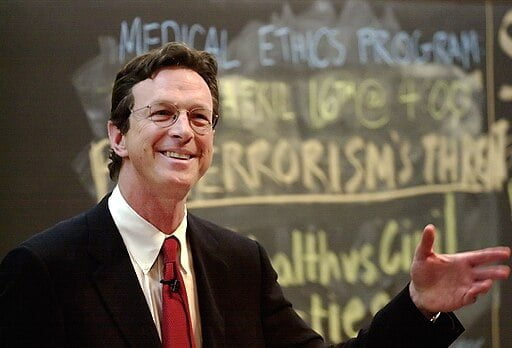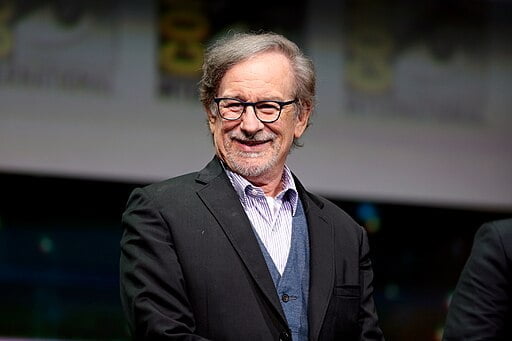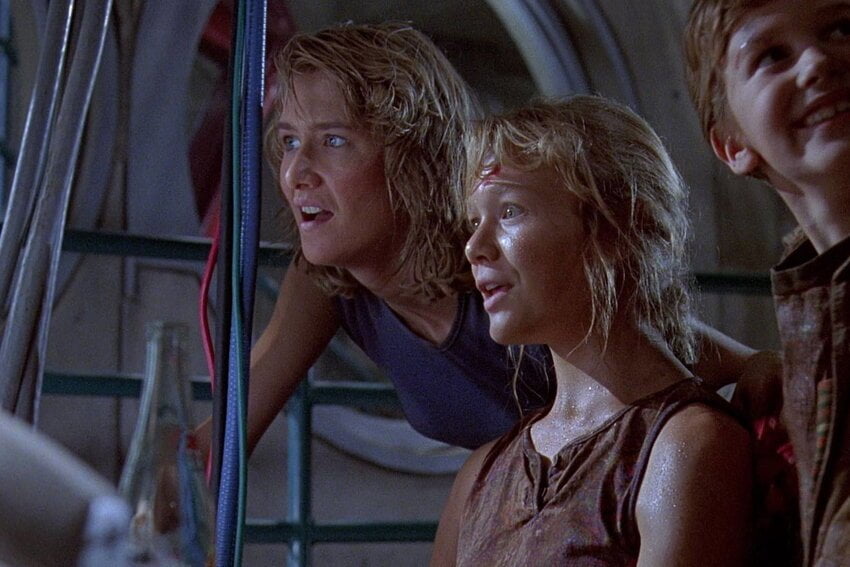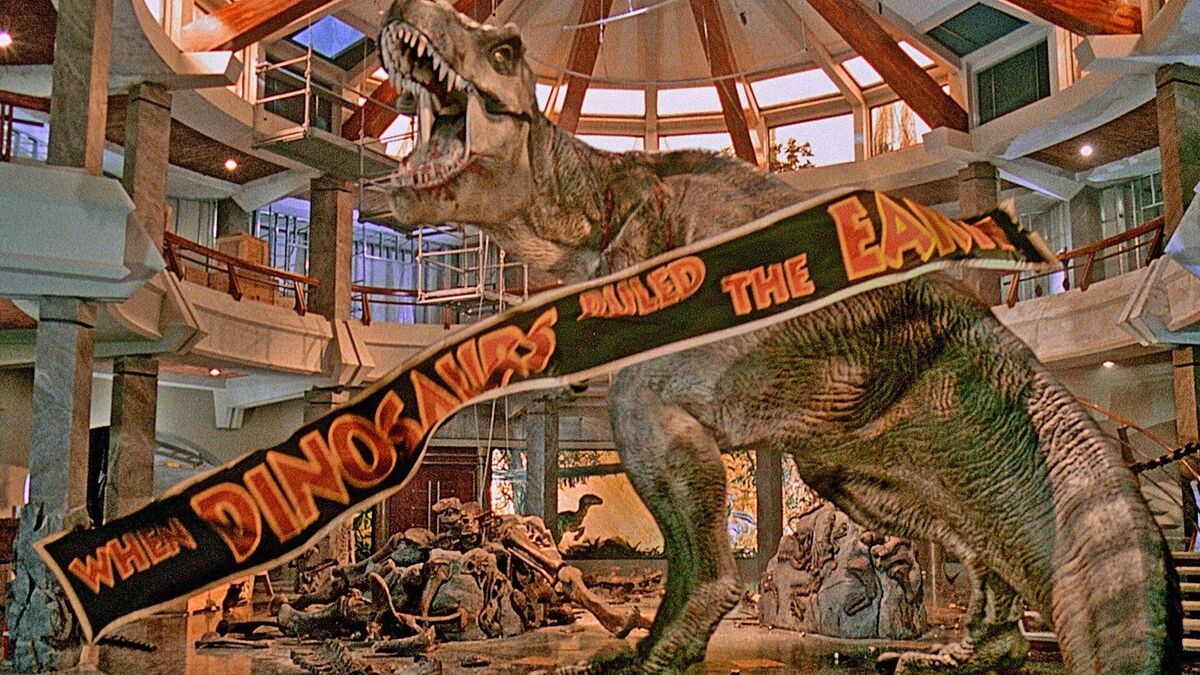Jurassic Park may be the most impactful film of the twentieth century. 2023 marks the 30th anniversary of this monumental movie. Why was Jurassic Park so popular?
Jurassic Park benefited from an exceptionally talented film crew, pioneered groundbreaking special effects, and capitalized on a growing public interest in dinosaurs and technology. These factors created a perfect storm that made Jurassic Park more influential than prior films.
While this is a simple overview, it doesn’t tell the whole story. If you’d like to know how this all came to be, keep reading.
Jurassic Park by Michael Crichton
Why was Jurassic Park so popular? Well, Michael Crichton surely knew what he was doing.
Crichton’s first attempt at this story began as a screenplay in 1983. In this story, a graduate student recreates a pterosaur. While Crichton’s work was originally aimed at children, his editor wanted him to make a scarier book. This is when Jurassic Park turned into a horror sci-fi novel.
In 1982, paleontologist George Poinar, Jr. and his wife, microscopist Roberta Hess, published an article titled “Ultrastructure of 40-Million-Year-Old Insect Tissue.” In it, they describe a fly preserved in Baltic amber.
You can find this article on science.org though it is locked behind a paywall. Poinar conducted an interview with sciencefriday.com that sheds some light on the impact of his paper on Crichton’s work.

Crichton had Jurassic Park but still needed a convincing way to bring back dinosaurs. After contacting Poinar, the story began to take shape.
While we now know that dinosaur DNA reconstructions from amber are impossible. We cover resurrecting dinosaurs from amber in another article. It’s got a lot of information about why the amber approach would not work. At the time, however, this was an idea postulated by some scientists.
While audiences will generally accept even the most outlandish fiction, Crichton created a respectable scientifically-minded story. This separates the Jurassic Park story from the typical B-movie horror and allows it to resonate with a more sophisticated tone.
Crichton consulted various scientists while researching his book. This has limits, as science has progressed in the past three decades. Still, fans of the franchise can appreciate the tremendous effort to make Jurassic Park believable.
Each chapter keeps readers engaged with dazzling visuals of computer screens and fractal images. The condescending Dr. Ian Malcom’s banter often challenges reader assumptions as he contradicts common wisdom.
This is why Jurassic Park never feels cliched. It reads like Mary Shelley’s Frankenstein.
A critical expose of human arrogance that remains timeless and always feels relevant. Consider the progress of machine learning in the modern day.
Michael Crichton’s novel served as the foundation of the most successful franchises in movie history. Had the story lacked compelling characters and believable science, it would have faded into obscurity.
If you’d like to learn more about Michael Crichton’s novels Jurassic Park and Lost World, we have covered both of them previously.
Crichton did go on to assist in the script-writing process for Jurassic Park. If you’d like to know more about Crichton’s involvement and other interesting facts about the production, Jurassic Outpost has a great resource on this.
While some will prefer Crichton’s novels to the film adaptations, people overwhelmingly know Jurassic Park from the 1993 film. How did Steven Spielberg’s direction make Jurassic Park a classic?
Steven Spielberg Gives Jurassic Park Direction
No other director could have pulled off Jurassic Park. Steven Spielberg possessed a particular magic that made Jurassic Park so popular compared to other films in the genre. What was the secret sauce?
In his own words, Spielberg directed Jurassic Park from the perspective of a child. He understood the pull that dinosaurs hold over children and created a movie that he would have wanted to see as a child.

The movie covers some pretty dark ground. Spielberg manages to mix awe and wonder between scenes of terror in a way that makes audiences appreciate the dinosaurs more than traditional movie monsters.
The dinosaurs are characters too. The portrayal of dinosaurs is done so convincingly that you can forget that they’re only movie props. They look alive.
While other directors might have simply settled for the technology of their time, Speilberg was invested in going beyond what had been done before. His eagerness to embrace emerging technologies where appropriate set a high bar for filmmaking for generations to come.
While Spielberg’s pitch to Crichton landed him the job, other directors were in the running. Screen Rant covers how these alternatives might have played out. In short, the movie would have flopped.
Spielberg knew when to make changes to Crichton’s story to fit his vision. The characters are better known for their charismatic film adaptations than the more pessimistic ones from the novels. More on that later.
Casting Choices Made Jurassic Park Iconic
Steven Spielberg made it very clear that when casting for Jurassic Park, he wasn’t after the biggest stars but the best actors. He succeeded, as the film’s cast portrayed their roles flawlessly.
Jeff Goldblum portrayed the iconic Ian Malcolm, capturing both the wit and charisma of the character in Crichton’s novel. His scenes created a pop culture phenomenon.
While faithful to the novel, Malcolm is far more likable in the movie. He mocks the hubris of John Hammond and the park staff. His lines are delivered in a constructive way rather than the arrogance of the novel.
Then there is Laura Dern, who displays courage in the face of danger. She exudes confidence when challenged by her male counterparts. Her portrayal of Dr. Ellie Sattler has long been recognized as a strong female lead who overcomes stereotypes in media.
We have Sam Neil portraying the paleontologist Dr. Alan Grant in his journey to accept the new world that is emerging before his eyes. His growth on screen and practical skepticism despite his passion for dinosaurs is a perspective that resonates with audiences.
Spielberg decided to cast Ariana Richards as Lex Murphy and Joseph Mazzello as Tim Murphy, shaking up the characters from the book. In Crichton’s novel, Lex is the younger sister who is often helpless in crisis while her brother is a dinosaur nerd and computer whiz.

Instead, Spielberg makes Lex the older sibling and the hacker who saves the day by activating the park security systems. This change enabled both children to be helpful to the adults and showed a young girl who was proficient at computers when the adults around her were powerless.
There are numerous other characters that Spielberg adapted for the better in many ways. The last one I’ll touch on here is the park’s founder: John Hammond.
While the Hammond from Michael Crichton’s Jurassic Park is a stubborn, arrogant capitalist to the end, Spielberg’s Hammond is a dreamer who dreamed too big. Audiences can understand the genuine ambition of Mr. Hammond while never seeing him as the villain.
Richard Attenborough delivered a compelling performance that made viewers question the morality of the ambiguous subject of dinosaur cloning. This contrasts with the novel version which has clear villains and draws a line in the sand about who is morally right.
The casting of Jurassic Park was as perfect as movie casting can be done. Each cast member played their role with care.
These character adaptations stand as a key component that made Jurassic Park so successful. Not only was each role believable, but they were also the most suitable for audience reception.
John Williams Composes the Score for Jurassic Park
When you mention Jurassic Park to someone, chances are good that they can hum the main theme. Why was John Williams’s score so impactful?
The score for Jurassic Park coincides beautifully with the actions on screen. The movie moves from moments of awe to moments of terror as events unfold. Again, this serves the tone of the film.
There are breaks in the action to allow the characters to reflect on their mistakes. This necessitated specific musical cues that conveyed these moments.
What makes this feat more impressive is that Williams needed to create character music for dinosaurs he had never seen. While the CGI animals were absent, the score for the scenes where they’d be placed in post-production was composed.
There is a significant amount of research on how music impacts the human brain. Phys.org explores this relationship in greater detail. Jurassic Park benefited greatly from the profound musical score that emotionally connected audiences to the film.
The music gave personality to the iconic dinosaurs on screen, just as Spielberg intended. A movie needs more than a captivating score, it needs strong visuals. How did they pull this off?
Stan Winston Studios Create Dinosaurs for Jurassic Park
Jurassic Park would have never been convincing were it not for the practical effects created by Stan Winston. Stan Winston Studios worked on many significant films of the time including Aliens, Predator, and Terminator 2.
This captured the attention of Spielberg. The plan was to create life-sized dinosaurs for particular shots and defer to go-motion animation for wide shots.
Spielberg knew the troubles associated with mechanical stars from his direction of Jaws. The animatronic shark was a nightmare that faced serious technical difficulties.
Winston’s team was able to create some of the most advanced animatronics ever designed. They had to withstand the demands of a major studio production.
From the incredible breathing Triceratops, eerie Velociraptor suits, and life-sized Tyrannosaurus, audiences witnessed the pinnacle of this technology. Each dinosaur takes on a personality of its own on-screen because they were done with such care.
The realism that these animatronics provided can’t be overlooked. It’s rare that effects from a movie hold up to modern standards decades after release. Many people scoff at the effects in the modern Jurassic World films when compared to the Stan Winston animatronics.
Sadly, modern movies often rely too heavily on CGI and neglect the impact of practical effects. This includes the Jurassic World trilogy as well, though Jurassic World Dominion addresses this to some extent.
For more on the production of dinosaurs at Stan Winston Studios, check out this article by stanwinstonschool.com. There you can learn about the behind-the-scenes struggles to bring dinosaurs back to life.
While the Winston animatronics were at the peak of practical effects, the future of filmmaking lay in CGI. How was the team going to capture the full-bodied dinosaurs in action?
Industrial Light and Magic Create Dinosaurs for Jurassic Park
While the practical effects were way ahead of their time, Spielberg faced a challenge when it came to presenting full-sized dinosaurs for wide shots. The go-motion techniques employed by Phil Tippett’s team had started to show their age.
Spielberg was determined to make the dinosaurs look as convincing as possible. When Industrial Light and Magic (ILM) demonstrated what CGI could do for the film, Phil Tippett’s go-motion animation was toast.
Spielberg still valued the work of Phil Tippett and wanted to keep him as part of the crew. Tippet’s animators had a great deal of experience in animating animals.
This knowledge benefited ILM and helped ensure lifelike movements for the dinosaurs. New technologies, such as the Dinosaur Input Device, allowed Tippet’s team to incorporate their animation techniques into CGI models.
Had Spielberg accepted the status quo and chosen to ignore the growing field of CGI, Jurassic Park would likely have fallen flat in the eyes of moviegoers. The choice to push boundaries led to some of the most iconic shots in all of cinematic history.
Jurassic Park altered the way people imagined dinosaurs, unlike any movie before it. This was perhaps the greatest influence on the emergence of a dinosaur craze during the 1990s.
Public Interest in Dinosaurs and Technology Skyrockets
Dinosaurs had a major explosion in media during the 1990s, and a big part of it was thanks to Jurassic Park. It not only revived the fascination with dinosaurs but also sparked a whole new wave of dinosaur-related movies, TV shows, toys, and merchandise.
This sudden surge of dinosaur mania had a significant impact on society, as it fueled the imaginations of both children and adults, leading to increased scientific interest and a renewed appreciation for dinosaurs.
Did Jurassic Park alone do this? It surely sparked public interest in dinosaurs, particularly among adults.
Jurassic Park showed dinosaurs as active and birdlike. The radical shift from the lumbering beasts that most people were familiar with from portrayals in the past made them more curious about what the real animals were like. This spurred increased media coverage of scientific expeditions.
With increased exposure comes increased funding. The conversation.com has a great article that discusses the legacy of Jurassic Park and its impact on the study of paleontology.
It goes without saying that children were highly influenced by Jurassic Park. The capitalists understood how impactful the film was and sought to capture a piece of the pie.
The Land Before Time series, We’re Back! A Dinosaur’s Story, and even Carnosaur, owe their success to the emerging dinosaur craze. Iconic shows such as Dinosaurs and Barney & Friends became cemented into pop culture.
If you were interested in dinosaurs, the 90s were a dream come true. We have another article on the influence of dinosaur media on public perceptions of dinosaurs.
Why was Jurassic Park so Popular Compared to Other Movies?
Jurassic Park stood out from similar films at the time because of its incredible visual effects, iconic score, and well-rounded cast. The compelling science fiction story from Michael Crichton combined with Steven Spielberg’s talented direction produced a one of a one-of-a-kind story unlike any that audiences had ever seen.
The prominence of dinosaurs in pop culture that coincided with many revolutionary scientific discoveries spurred public interest to new heights. Many dinosaur enthusiasts today owe their professions to the dinosaur craze that occurred in part due to the success of Jurassic Park.
If you learned something today, please share this article. When did you first see Jurassic Park and what stood out the most for you? Leave us a comment to let us know your thoughts.

